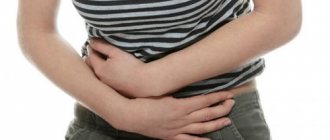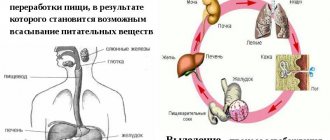Bloating and nausea - every person has experienced these symptoms in their life.
These symptoms can appear when consuming low-quality products, bad habits, constant stress and the presence of pathological processes in the gastrointestinal tract.
These symptoms can cause not only discomfort to the patient himself, but also to people who are nearby.
In a healthy body, all processes occur unnoticed by humans.
The accumulation of gases in the intestines is an absolutely normal process, but if the internal organs of the gastrointestinal tract are disrupted, the process of gas formation can occur with certain symptoms.
This may include diarrhea, weakness, nausea, headaches and dizziness.
The appearance of gases
The formation of gases in the organs of the digestive system occurs constantly:
- most of the gases in the stomach appear when food enters the intestines for processing;
- a small amount of gas enters during the eating period. The amount of air increases significantly if a person is talking at this time.
Gases are removed from the body:
- throughout the day through the anus. In most cases they have neither smell nor sound;
- some gas returns to the mouth in the form of belching;
- absorbed into the blood through the walls of blood vessels.
Preventive actions
As a prophylaxis, to prevent the causes of the disease and further treatment, it is necessary:
- Lead a healthy lifestyle. You should give up bad habits - smoking and drinking alcohol;
- Spend as much time as possible outdoors;
- Do not be nervous, avoid conflicts, emotional turmoil;
- Adjust your diet. Meals should be balanced and complete. Conducted at certain hours;
- When preparing food, sanitary standards must be observed;
- It is necessary to conduct an examination of the body at least once a year;
- You should move more, play sports, and exercise. You can sign up for yoga or massage courses;
Bloating and colic can occur for various reasons. They may be a consequence of diseases of the gastrointestinal tract. Simultaneously with the disease, flatulence, bloating, and fever may occur.
People may experience a bloated stomach. Treatment includes the use of medications and physical therapy. In particularly severe cases, surgical intervention is used.
There is useful information on the topic in this TV show.
Causes
Bloating occurs in people of all ages and for a variety of reasons.
Nausea may be accompanied by discomfort in the stomach, and in most cases, causes vomiting.
Diarrhea after eating fatty foods. Flatulence has several official names in medicine: tympany, flatulence, flatulence.
If these three symptoms appear simultaneously, they may indicate the presence of serious diseases of the gastrointestinal tract.
Gastrointestinal tract dysfunction
It is expressed in symptoms such as bloating, diarrhea and nausea in the presence of diseases of the gastrointestinal tract.
For example, when the walls of the stomach and duodenum are damaged by the bacterium Hilobacter pylori, the production of enzymes is disrupted and food does not move well towards the intestines.
Due to stagnant processes, food begins to decompose in the gastrointestinal tract. This phenomenon is accompanied by the release of a large amount of gas.
If the functioning of the pancreas, liver, gallbladder is disrupted and the presence of irritable bowel syndrome, loss of appetite, abdominal pain, diarrhea and flatulence may additionally occur.
Sometimes such symptoms occur in the presence of malignant or benign tumors.
If the organs of the gastrointestinal tract are affected by parasites, the toxins they secrete can cause bloating.
Additionally, vomiting, belching, nausea, constipation or diarrhea, or their alternation, may also occur.
Other reasons:
- lactose intolerance. It is necessary for processing dairy products. There is an individual reaction to the consumption of dairy products;
- if a person eats quickly, the air that gets in becomes the cause of bloating;
- Overloading the gastrointestinal tract with a large number of products can lead to the fermentation process. This is due to disruption of the stomach, secretory function and lack of pancreatic enzymes;
- belching may appear after drinking a large amount of carbonated drinks or kvass. Among food products, cabbage, legumes and sweets can cause flatulence;
- taking medications. Antibiotics have a particularly negative effect on the functioning of the gastrointestinal tract. They kill the normal microflora of the digestive system;
- symptoms that only occur in women. Bloating, diarrhea, belching and nausea may occur before the onset of the menstrual cycle. There is a restructuring of the body's hormonal levels;
- Another symptom that concerns women is the onset of menopause. In addition to flatulence, a problem such as dizziness may occur.
Diagnosis of diseases
All diseases related to digestion are dealt with by a gastroenterologist under the direction of a general practitioner. The reason for such a visit can be any unpleasant symptom - nausea, bloating, constipation, acute pain.
If the disease is neglected, chronic pathology can provoke an exacerbation and lead to surgery.
Before visiting a gastroenterologist, it is necessary to do a detailed biochemical blood test. To complete the clinical picture, the therapist recommends an ultrasound of the abdominal cavity and an endoscopic examination.
Next, the gastroenterologist may resort to the following types of examination:
- X-ray of the digestive organs;
- electrographic studies;
- electrometric diagnostic methods;
- assessment of intestinal motor activity, recording of sounds.
Modern computed tomography has become widespread. It makes it possible to scan images of tissues layer by layer. Thanks to CT, the doctor can evaluate the structure of the tissues of the intestines and stomach. The choice of diagnostic method is always associated with the characteristics of the disease itself and its course.
Medical causes of nausea, vomiting and bloating
- constipation. An adult should have a bowel movement every day. Otherwise, bloating may occur;
- Pathological changes in the intestine, resulting in obstruction;
- irritable bowel syndrome;
- pregnancy. Hormonal changes in a woman’s health, especially in the first months of pregnancy;
- indigestion. Burning sensation in the upper abdomen, gas formation, belching;
- chronic heart failure;
- tumor of the intestine and liver.
Differences between intestinal colic and other similar conditions
- Intestinal colic is accompanied by severe abdominal pain that occurs due to problems with the gastrointestinal tract.
- Intestinal colic with bloating indicates the formation of flatulence.
- Spasms, colic, and a feeling of nausea may indicate food intoxication.
- Intestinal colic and bitterness in the mouth indicate liver failure.
- Acute pain on the right side, colic in the abdominal area may indicate an acute form of appendicitis.
If symptoms occur accompanied by colic in the stomach, you must contact a specialist to determine the cause. After diagnosis, appropriate treatment must be prescribed.
Why does pain, diarrhea and bloating occur?
- chronic gastritis. It is necessary to follow a constant diet. If a person begins to consume prohibited foods, then diarrhea and flatulence will appear very soon;
- antibiotic treatment. If a person uses antibiotics for a long time, this leads to disruption of the intestinal microflora;
- gastrointestinal tract infections. Not only does abdominal pain, diarrhea and flatulence occur, but at the same time an increase in temperature appears;
- weakened immunity due to the presence of chronic diseases of the gastrointestinal tract;
- In the case of surgical intervention in the abdominal cavity, the formation of adhesions is possible. Also, failure to follow certain rules after surgery can lead to diarrhea and flatulence.
Despite the variety of diseases, the main cause is considered to be poor nutrition. Sometimes, no matter how severe the symptoms are, the underlying cause is poor diet.
Nausea and bloating may occur after eating. Therefore, it is important not only the quality of the products, but also how a person consumes them, and in what proportion.
Times have changed, but the table culture remains the same. If earlier it was cold and the diet consisted of fatty dishes, now the climate has changed, but people still haven’t changed their favorite dishes.
The main nuances of malnutrition are that:
- a person tries to swallow as quickly as possible, forgetting to chew the food thoroughly. In this regard, a large amount of air penetrates, which causes bloating;
- drinking large amounts of carbonated drinks.
At first, such nutrition causes diarrhea and flatulence, and then they become constant companions of a person.
People try to eliminate this symptom with the help of medications, but it is necessary to restore the functioning of internal organs, and not just eliminate the symptoms.
Poor diet and medication use
Bloating may be accompanied by additional pain in the lower abdomen.
Gases are produced by bacteria that process food. They lead to an increase in the volume of the intestines, and it begins to put pressure on organs that are close.
If food leaves the body in a timely manner, then fermentation does not occur. The causes of such discomfort may be caused by drinking carbonated drinks.
Also, if a person consumes foods that are not related to each other, they can cause flatulence.
Nausea occurs after overeating. The body cannot cope with the abundant amount of food that comes into contact with it.
Also, such a symptom can appear from vegetables and fruits, which contain a huge amount of various additives.
Sometimes the cause of this type of discomfort can occur due to congenital pathologies.
For example, when the body does not produce the required amount of enzymes to break down dairy products.
Bloating, weakness, nausea and vomiting can be a signal from the body about drug poisoning. In some cases, this is a side effect from them.
For example, after taking antibiotics, a disruption in the functioning of the gastrointestinal tract occurs.
This is due to the fact that antibiotics can kill both bacteria that lead to the development of an inflammatory process in various organs, as well as bacteria that are necessary for processing food masses. A disease called dysbacteriosis develops.
Description The simplest and most obvious reason. Gases can form quite naturally: you need to drink a lot of juice or soda, eat a lot of pickled or meat.
The main problem: overeating, as it leads not only to increased gas formation and obesity, but also overloads the intestines, which at a certain point can simply weaken.
Depends on how much and what the person ate. Soda – sharp and moving pain. Meat dishes - severe and immovable pain. The causes of burning pain usually lie in very spicy and sour foods. In any case, pain occurs several hours after eating. Flatulence, nausea, bloating, limited mobility, weakness. Therapist, nutritionist, gastroenterologist.
Methods: anamnesis.
Changing eating habits, developing an individual diet.
When to seek help from a doctor
You should immediately consult a doctor if you have the following symptoms:
- severe headache in the abdomen and dizziness;
- constant weakness;
- the appearance of a few drops of blood in the stool;
- vomiting blood;
- belching after eating;
- painful sensations behind the sternum;
- diarrhea after every meal.
The need for additional consultation with a specialist is necessary:
- nausea in the morning after getting out of bed;
- disruption of bowel function for 2 days;
- a person begins to lose weight sharply and quickly;
- the body becomes dehydrated. A person cannot drink water due to nausea;
- diarrhea appears after a person has eaten;
- The reason for visiting a doctor may be symptoms that have never appeared before and prevent you from living a full life.
Types of intestinal dyskinesia
- Rectum. This type of disease is also called rectal colic. It is characterized by false acute painful sensations when emptying the rectum;
- Pancreatic. Formed when pathologies of the pancreas occur. Symptoms include diarrhea, gag reflexes, bloating, and nausea. Localization of pain occurs in the upper abdomen on the left. The nature of the pain is shingles. Due to this manifestation, pancreatic tumors and an acute form of pancreatitis may occur;
- Lead. This type of disease occurs due to lead intoxication. Adults experience cramping pain in the abdomen. There is an increase in body temperature to 39°C. Tension occurs in the muscles of the abdominal wall. The gums begin to bleed. Gray plaque appears between the gums and teeth. In most cases, such manifestations are observed in employees working in hazardous industries. People engaged in lead mining and smelting are exposed to this risk. The disease can occur in molar workers, workers producing cables and batteries;
- Hepatic. With this type of disease, pain and cramping are observed in the right hypochondrium. They can radiate to the shoulder and scapula on the right. In this case, patients experience a bitter taste in the mouth. A feeling of nausea begins to form. Vomiting with bile is observed. This disease is provoked by an acute form of cholecystitis, cholelithiasis;
- Appendicular. It is observed in the initial stage of acute appendicitis. Has intense increasing pain that occurs in the iliac region on the right;
- Renal. Accompanied by sharp, intense pains radiating to the genitals, groin and lower back. They may get worse with movement. Patients experience an increase in body temperature up to 39°C. There is a sharp decrease in blood pressure and urination problems. Vomiting and a feeling of nausea are formed. If specialists do not intervene in a timely manner, a person may faint and lose consciousness. This form of the disease occurs with tumors, urolithiasis, pyelonephritis, kidney tuberculosis;
READ MORE: Abdominal pain and bloating: treatment and symptoms
Treatment
Treatment for nausea and bloating depends on the cause of the disease.
If the main etiological factor of these symptoms is poisoning of the body, then it is necessary to use drugs to eliminate intoxication.
For example, Activated carbon is suitable (you need to use 1 tablet per ten kilograms of weight, but no more than 6 pieces at a time) or Smecta. These are sorbents that can eliminate discomfort in the abdominal area and diarrhea.
If bloating, diarrhea and nausea occur due to the fact that the pancreas does not produce enough enzymes, then medications such as Creon and Pancreatin will help. They contain bile and pancreatic enzymes.
There are drugs that eliminate the formation of gases. The main active ingredient is simethicone. For example, Kolikid, Relzer, Meteospasmil.
A small amount of gases enters the blood, the rest is eliminated thanks to drugs such as Dimetikon and NoGasin.
If diarrhea and bloating do not go away, then you need to undergo diagnostics. In most cases, the doctor prescribes prokinetics and enzyme preparations.
Gastritis
This is an inflammatory process of the stomach. The reasons for its appearance may be different. For example, low-quality products, unhealthy diet, eating food on the go.
It goes away with symptoms such as heartburn, vomiting, nausea, pain in the abdomen, and belching.
As we have already said, gastritis is a very broad concept, something of a collective term for a group of inflammatory diseases of the stomach.
We describe specific types of the inflammatory process separately, but here we give the most general idea of the variants of the clinical picture.
Chronic gastritis develops gradually and in the early stages can proceed almost unnoticed, later it worsens from time to time.
Early signs of the disease are sometimes:
- hair loss;
- sudden weight loss;
- brittle nails;
- skin problems;
- thick coating on the tongue;
- characteristic odor from the oral cavity.
Some more specific deviations from the norm are initially detected only during hardware diagnostics.
Traditional medicines
When a person experiences bloating, belching and diarrhea, you can additionally use folk remedies. Suitable for this:
- chamomile tea;
- Pour dill seeds with water and leave to infuse for several hours. But such treatment is absolutely not suitable for pregnant women;
- Boil the parsley root for several hours and leave to infuse in a dark room for 24 hours;
- you need to use lemon balm infusion for bloating, constipation or diarrhea.
Chronic pancreatitis
During an exacerbation, the patient experiences symptoms such as nausea, vomiting, bloating, abdominal pain and fever.
The causes of such conditions are due to poor circulation or congestion in the gallbladder.
Prevention of these diseases is to follow a diet. It is necessary to avoid eating fatty, fried and smoked foods.
An exacerbation may also occur due to the fact that a person eats cabbage or tomatoes.
It is recommended to take medications that artificially replenish the body with necessary enzymes. It is advisable to take them until the exacerbation completely disappears.
DescriptionIn acute pancreatitis, gas formation does not have time to occur, as this condition develops quickly. In chronic cases, rumbling occurs often, since chronic pancreatitis is a sluggish inflammation of the pancreas, during exacerbations of which the latter does not produce the required amount of enzymes.
The mechanism for the development of symptoms is similar to a common enzyme deficiency, but the main difference is that pancreatic enzymes primarily break down lipids (fats) and oligo-/polysaccharides (carbohydrates).
Therefore, symptoms occur after eating fatty and carbohydrate-rich foods.
The condition is characterized by either burning or aching pain in or under the stomach. Intensity – weak or moderate. General weakness, slightly elevated body temperature, nausea, and in severe attacks – vomiting with bile. Gastroenterologist.
Methods: blood test for amylase, ultrasound.
A strict diet low in fat and carbohydrates; during attacks, use enzyme-based medications.
Description Each important organ has its own “latrine” into which it secretes waste products. Most often these are lymph nodes, but the liver has its own personal organ - the gallbladder.
It is in it that the harmful results of work accumulate, which then enter the intestines and are excreted. Unfortunately, the gallbladder can become inflamed, and this disease is called “cholecystitis.”
The causes of acute cholecystitis are stones, while chronic cholecystitis can occur without them. One of the causes of chronic cholecystitis is bacteria that actively multiply in the gallbladder.
Hence the pain and rumbling.
The pain increases slowly and is located slightly below the liver. After taking the necessary medications, they also slowly disappear. Diarrhea, elevated body temperature, flatulence, unnatural color of stool. Gastroenterologist. Methods: blood, urine and stool tests, palpation of the gallbladder, ultrasound (for the presence of stones). Antibacterial therapy, medications to increase the flow of bile, diet.
Prevention
If you have such alarming symptoms as diarrhea, bloating and weakness, you must first reconsider your diet.
It is necessary to avoid such products as:
- sweets that contain carbohydrates that are easily digestible;
- carbonated drinks;
- kvass;
- alcoholic drinks;
- To eliminate heartburn, you should not use soda. It contributes to the worsening of the situation. It is best to purchase a drug at the pharmacy that will help eliminate the unpleasant symptom.
Acid reflux
A disease in which symptoms such as bloating, belching, heartburn, and abdominal pain often occur.
The main cause of this condition is a problem in the functioning of the muscle valve. It is located between the stomach and esophagus.
Due to the weakening of this sphincter, gastric juice is thrown into the esophagus. This causes heartburn, nausea and bloating.
Most often, this disease occurs in parallel with gastritis and high acidity.
Yeast belching
Gas formation and belching are often manifestations of certain individual diseases. They are almost always accompanied by additional symptoms (pain, nausea, general weakness), and the degree of their severity largely depends on the individual characteristics of each individual case.
Nevertheless, belching with rotten eggs or yeast remains quite characteristic. This sign should alert any patient, since in most cases it can be a manifestation of a serious pathology that requires full treatment. Rotten belching and gases (bloating) accompany hypoacid gastritis. It is manifested by a decrease in stomach acidity, which causes insufficient chemical processing of food in its cavity. As a result, the food begins to rot with the release of gases, which provide a characteristic unpleasant odor.
In addition, malignant neoplasms in the stomach can cause symptoms such as yeast belching and diarrhea. If they are combined, you should definitely contact for a more thorough examination and selection of a treatment method.
Flatulence in healthy people
Flatulence can occur in healthy people due to errors in diet:
- when drinking carbonated drinks;
- when swallowing food in large portions;
- when consuming foods that cause fermentation (fiber, legumes, baked goods).
Some patients experience bloating after drinking milk. In most cases, the occurrence of this symptom is due to the absence of the lactase enzyme, which is involved in the breakdown of milk. Normalizing the diet, which consists of switching from whole milk to fermented milk products, improves the situation. In all these cases, temperature readings are normal.











